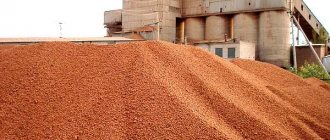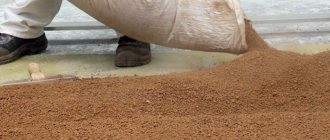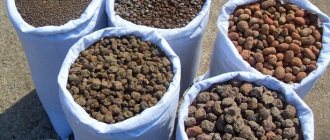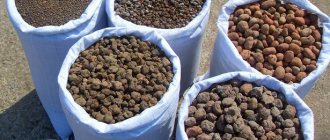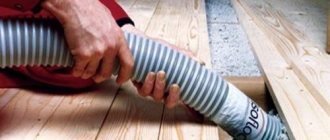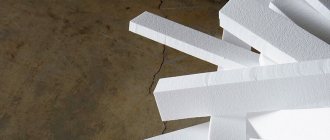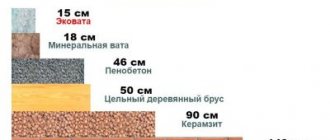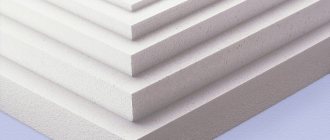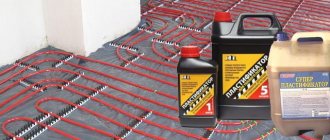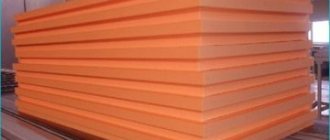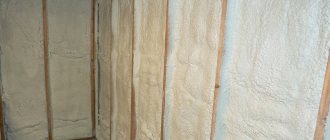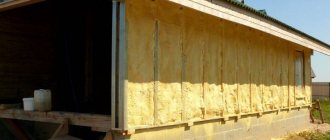Nowadays, the cost of heating housing and premises in general is constantly increasing. At the same time, for some reason, salaries remain almost the same - not a good trend, but it has to be taken into account. In such conditions, almost every owner of a house or apartment begins to worry about the issue of saving energy. Today, walls, floors, ceilings, and slopes are being insulated en masse - such measures make it possible to distribute heat throughout the room as efficiently as possible due to the fact that the level of heat transfer of the building is reduced.
This article will touch upon such a difficult issue as floor insulation - we will figure out what is better suited for this: mineral wool or expanded clay. In principle, foam plastic is also often used, but this is not the best option, because the possibility of ventilation and ventilation of the ceiling practically disappears. Although, undoubtedly, the thermal insulation characteristics of polystyrene foam are excellent.
So, mineral wool and expanded clay, which is better - you can start with a review of the first material and compare everything based on specific properties.
Mineral wool and its properties, features
This insulation consists of soft coarse fiber boards or rolls. This material is made from waste metal and carbon alloys of various minerals such as basalt. In its structure, it resembles glass wool, only the latter is much worse in terms of thermal insulation characteristics. In principle, mineral wool is used quite widely in construction and is especially popular for insulating facades. However, the facade is not floor insulation - there are still different specifics.
The main advantages of this insulation are considered to be several points.
- Durability.
This is a rather controversial property, since in order for the insulation to last for a really long time, it is necessary to ensure that there is no moisture in the space where it is laid. Weak resistance to moisture is the main drawback of the material, because if the mineral wool gets wet, then all the thermal insulation qualities in this place are instantly eliminated. Of course, manufacturers have now learned to treat rolls with various moisture-proofing compounds, but this does not always work effectively.
In addition, mats and rolls are afraid of mechanical damage, that is, simply put, they can tear even due to the activity of mice. Therefore, the question of durability is still largely questionable. It is difficult to 100% protect such insulation.
- Quick installation.
This is true, but it is also debatable - what is easier - to roll out the rolls on a flat surface or to fill the space with expanded clay? There is not much difference in difficulty. Therefore, compared to working with expanded clay, this quality is definitely not an advantage.
- Fire resistance.
Likewise, expanded clay is also not afraid of fire.
- Breathability.
What is, that is - basalt roll has good vapor permeability, due to which steam, in theory, will not accumulate in the floor space. However, if this same quality is applied to expanded clay, then the same situation is visible here - steam passes perfectly between the scattered granules of the material and, accordingly, the vapor permeability here is also high.
It turns out that while the rolled insulator is “losing” to expanded clay due to the fact that it is afraid of moisture and is not very tensile strength.
Now it’s time to consider the structure of expanded clay.
Thermal insulation of the floor with mineral wool on joists
One of the ways to insulate a floor is to lay it on joists.
Floor insulation using joists is carried out on the ground. The underground space with this method will be cold. If the house is brick, then it is necessary to insulate the foundation of the house. This is caused by the high thermal conductivity of the brick and the possibility of the formation of cold bridges. Thermal insulation using the joist method is often carried out in wooden houses, since wood has lower thermal conductivity.
Modern insulation materials are very effective. But sometimes their use leads to freezing of the base in wooden buildings. This opposite effect is associated with the high tightness of modern heat insulators and the obstacle to heating the underground space due to the heat of the house. Therefore, when insulating a wooden house with modern materials, thermal insulation of the base is also required.
The procedure for floor insulation by joists
- Compacting the soil.
- Laying a layer of crushed stone bonded with bitumen mastic. Bitumen is used for waterproofing.
- Installation of brick columns with a longitudinal interval of 2 m and a transverse interval of 60 cm.
- Waterproofing of columns.
- Laying wooden logs with a cross-section of 100x50 mm, which is sufficient to withstand the load on the floor.
- Fixing a windproof layer at the bottom of each joist. First, a metal mesh is attached, and a wind-protective film is attached to it. This is necessary so that the insulation layer does not fly apart under the influence of air currents under the floor of the house. This film is vapor permeable.
- Laying mineral wool insulation on film between the joists. Mineral slabs with a windproof coating are now being produced. In this case, metal mesh and film are not required.
- Covering the insulation with a layer of vapor barrier.
- Sealing joints between sheets.
- Flooring made of planks.
If the floor is wooden on a concrete base, then remove the boards and everything under them and clean the concrete surface. If the boards are in good condition and they are planned to be re-laid after insulation, then note the order of their arrangement and carefully remove them.
Then spread the waterproofing film. Logs with a cross section of 50x50 mm are laid on top at a distance of 50 cm from each other. Insulation is placed between the joists. An overlapping vapor barrier film is attached on top with small slats. The final stage: laying the finished floor.
When insulating the floor with mineral wool, it should be taken into account that the height of the floor will rise by approximately 50 mm.
Expanded clay as insulation
Essentially, it is a bulk material with pores. The granules are light in weight, which, in general, is not particularly different from the weight of cotton wool. Expanded clay is made on the basis of clay, which contains about 30% quartz, and, as you know, clay is a natural, natural insulation that does not emit any harmful fumes.
If we compare the latter quality with mineral wool, then the latter is not so good in this regard, because it contains small dust particles that are harmful to human breathing. In principle, since the roll will eventually be covered with various layers of insulators (not counting the finishing floor itself), it is practically impossible for these impurities to get into the air of the room, but this possibility still remains.
That is, here the third drawback of mineral insulation automatically arises (the first is the fear of moisture, and the second is low tensile strength) - it is not 100% environmentally friendly.
As practice shows, maximum protection from the harmful “side” of the issue is possible only with very competent and correct installation. And this is not always possible due to the different qualification levels of installers.
Of course, expanded clay may also have disadvantages in terms of environmental friendliness, but only in the case when the raw materials were mined in a quarry that has increased levels of radioactivity. This happens very rarely, but it’s still worth checking with sellers for safety certificates for the material.
Also, when buying expanded clay, you should pay attention to the following:
- Per granule fraction. For floor insulation, it is better to take smaller sizes - a gradation of 5-10 is optimal.
- For porosity. The more pores in the stone, the better the thermal insulation characteristics.
- The strength of the material - this affects the service life.
Here a difficult point automatically emerges in terms of using expanded clay - you need to try to find a good, high-quality material in order to achieve a low level of thermal conductivity. Basalt material “wins” here, since it is relatively standardized, and it is quite difficult to find a fake or defective product on the market.
Expanded clay is not afraid of moisture, since all the steam or all the water simply “passes” through the pores or directly into the granules of the material. There is certainly a percentage of moisture absorption here, but it is very small compared to soft insulation.
It is also worth noting such a point as the almost complete absence of the possibility of incorrect laying of expanded clay for floor insulation. Yes, choosing a material is quite difficult, but it is very easy to insulate with it, and the risk of any mistakes is minimal.
These are the main characteristics of expanded clay. Now we need to touch on the most important thing.
What is expanded clay
Expanded clay is a loose, porous, fairly lightweight building material. The main difference between expanded clay and other similar building materials is the use of special types of clay containing about 30% quartz as a base.
Expanded clay is produced by firing low-melting clay rocks that can quickly swell when heated to 1050-1300C for 30-40 minutes. As a result of thermal shock, round granules with a melted surface are formed.
We can say that expanded clay appeared thanks to defective clay bricks, when burned, sedimentary clay rocks swell. The release of gas and the transition of clay rock into a pyroplastic state during heat treatment is taken as the basis for the production of expanded clay. Most often, expanded clay is used to fill concrete structures and thermal insulation of foundations, floors, and roofs.
Specific thermal insulation parameters of expanded clay and rolled insulators
So, it turns out that the advantages and disadvantages of materials are known, but what happens if we compare their thermal conductivity? Everything here is actually quite simple.
For a clear example, you just need to take good quality insulators.
| Minvata | Expanded clay |
| Approximately 0.04 W/m*K | Approximately 0.09 W/m*K |
As can be seen from the table, cotton wool insulation has a better level of thermal conductivity than expanded clay, which means that to achieve the same thermal conductivity effect, the expanded clay layer for the floor must be made twice as thick as it would be when using basalt rolls.
If we talk about exact figures, then in average climate conditions the required thickness of wool on the ceiling should be about 7 cm according to SNIPs. Accordingly, to fill the expanded clay you will need a space of about 13-17 centimeters (it all depends on the quality of the granules). Of course, the numbers may vary in one direction or another, since the specifics of the situation are of great importance, but in general the ratio is approximately the same.
Based on all the above information, we can draw some conclusions.
Insulating the attic with mineral wool
To prevent the attic from being empty, it can be insulated and turned into an additional attic room or storage room. For thermal insulation of the attic space the following are used:
- Organic derivatives (polyurethane foam).
- Mineral wool materials.
- Bulk dry insulation (expanded clay).
For high-quality thermal insulation of the attic, all three types of materials are used and combined.
Mineral wool is well suited for insulating all surfaces of the attic: floors, walls and roof. Insulating an attic with mineral wool requires the additional use of external wind- and water-insulating polymer film. It is advisable to treat the metal surface of the roof with oil paint to prevent condensation during the cold season of the year.
Mineral wool has a loose structure and allows steam to pass through well, so the inside of the insulation is covered with a vapor barrier layer of foil polyethylene.
Mineral wool is used in the form of rolls and mats. The seams between individual fragments of insulation are carefully sealed with metallized adhesive tape.
Mineral wool is placed between the roof rafters, and on the floor - between the joists of the supporting structures. When performing thermal insulation work, it is very important to take into account the increased load on the support columns due to the weight of the insulation.
Therefore, before starting insulation measures in the attic, you should make sure of the strength of the supporting structures and the roof itself, and, if necessary, replace outdated worn parts.
Penoizol and expanded polystyrene
Polymer insulation materials, which include penoizol, polystyrene foam and expanded polystyrene, are also in great demand. Of course, insulating the ceiling with foam insulation or similar materials is superior to other methods in terms of efficiency and ease of use. Such insulation materials are very resistant to adverse conditions; they can withstand both low and high temperatures without deforming at all. Mold does not form on them, so the materials do not rot and can last a very long time.
In addition to thermal insulation properties, polymer insulation materials excellently absorb sound, and therefore can also be used as sound insulation. Despite their artificial origin, these materials are environmentally friendly and do not emit any harmful fumes.
But they also have disadvantages. Foam boards are quite fragile, and working with them requires care. During combustion, polymer insulation materials emit very acrid smoke. Well, besides, their prices are very high. There are insulation materials made from polystyrene foam or expanded polystyrene in the form of granules; this material is cheaper, but less effective for thermal insulation.
The most common places for using penoizol
